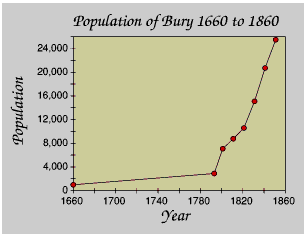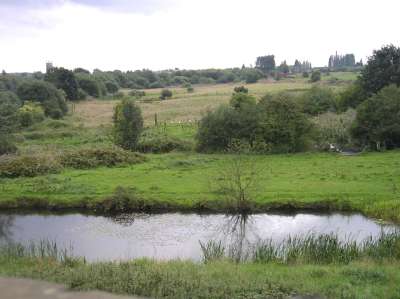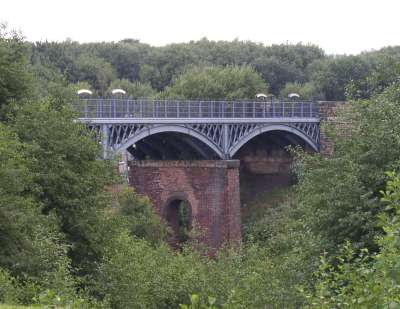Brief History of Bury - Page 4
Consolidation of Industry
During the nineteenth century industry in Bury diversified away from the textile business into engineering (including paper-making machinery) and chemicals, among others. In addition to numerous cotton mills, bleach works and dye works, some of the factories located in and around Bury in the mid nineteenth century include:
- An iron foundry on Crostons Road, Bury
- A brewery in Spring Lane, Radcliffe
- A 'Vitriol Manufactory' (sulphuric acid works) off Dumers Lane, Radcliffe
- A brick and tile works at Outwood, near Radcliffe
- Stoneclough paper mill at Ringley Road in Kearsley.
Much of the expansion of the town occurred in this period, as can be seen from the increase in population:

By the beginning of the twentieth century many other types of business had appeared in Bury. Within a mile or two of the town centre could be found:
- 9 Bleach works
- 6 Paper mills
- 3 Chemical works
- 29 Cotton and cotton waste mills (The waste mills used low grade cotton from the main spinning mills to produce yarn for cheaper cloth such as flannels.)
- 2 Hat works
- 6 Woollen mills
- 4 Boiler works
- 7 Iron foundries, forges and sheet metal works
- 2 Tanneries
- 2 Breweries
- 6 Dyeworks
- Derby Works building materials on Manchester Road. Now the Swintex factory, still with its italianate tower.
- A brick works, a felt works, a brass foundry, an oil and tallow works...
Bury-based companies also manufactured machinery for the papermaking and cotton industries, such as this 'self-acting' spinning mule made by Walker and Hacking in the 1880s:

Coal mining too was an important local industry, though mostly to the south and west of Bury, in Radcliffe and Outwood. Some of the local collieries were:
- Fernhill Colliery near Bury town centre
- Hinds Colliery alongside the Bury to Manchester railway
- Withins Colliery near the border with Radcliffe
- Black Cat Colliery on Cams Lane, off Bolton Road in Radcliffe
- Water Lane Colliery and Green Lane Colliery, both between Water Street and Sion Street in Radcliffe
- Outwood Colliery, between Radcliffe and Outwood
- Ladyshore Colliery at the side of the Bury to Manchester canal near Little Lever

Little sign now remains of these collieries except small hollows and mounds. This is the site of Withins Colliery which was operated by Andrew Knowles and Sons and had three shafts in 1892. It is located off Withins Lane between the Metrolink line and the canal, towards Radcliffe.
There were also many smaller 'coal pits' (small surface mines), at Warth Fold and Baldingstone for example. These local coal supplies were another factor in the development of industry in Bury.
Outwood Colliery once employed 2000 men and had tunnels stretching as far as Heywood. A railway line ran past the colliery on the way to Clifton junction and crossed the Irwell over the magnificent cast iron Outwood Viaduct.

Outwood Viaduct near Radcliffe town centre. Built in 1881 for £4225.



